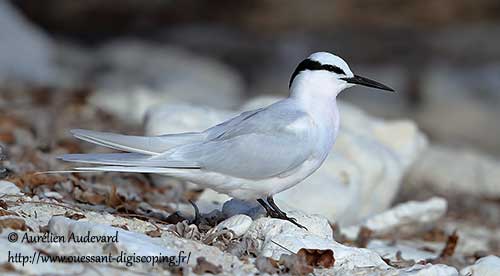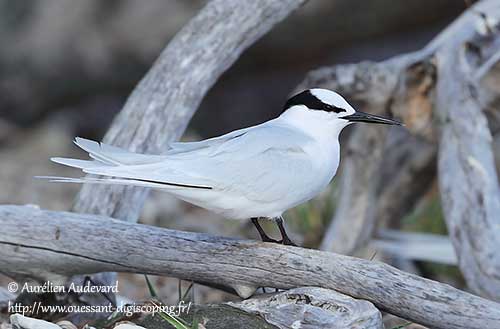
Fr: Sterne diamant
Ang: Black-naped Tern
All: Schwarznacken-Seeschwalbe
Esp: Charrán de Sumatra
Ita: Sterna nucanera
Nd: Zwartnekstern
Sd: svartnackad tärna
Photographer:
Aurélien Audevard
OUESSANT DIGISCOPING
Text by Nicole Bouglouan
Sources:
HANDBOOK OF THE BIRDS OF THE WORLD Vol 3 by Josep del Hoyo-Andrew Elliott-Jordi Sargatal - Lynx Edicions - ISBN: 8487334202
OISEAUX DE MER – Guide d’identification de Peter Harrison – Editions Broquet (Canada) – ISBN-10 : 2890004090 – ISBN-13 : 978-2890004092
Birds of Melanesia: Bismarcks, Solomons, Vanuatu and New Caledonia Par Guy Dutson – Editeur : Bloomsbury Publishing, 2011 – ISBN: 1408152460, 9781408152461
Birds of the Horn of Africa: Ethiopia, Eritrea, Djibouti, Somalia and Socotra Par Nigel Redman, Terry Stevenson, John Fanshawe – Helm Fields Guides – Editeur: Bloomsbury Publishing, 2010 – ISBN: 1408135760, 9781408135761
Birds of Madagascar and the Indian Ocean Islands Par Roger Safford, Adrian Skerrett, Frank Hawkins – ISBN: 1472924118, 9781472924117- Editeur: Bloomsbury Publishing, 2015
What Bird-The ultimate Bird Guide (Mitchell Waite)
THE AVIANWEB - Beauty of Birds (Sibylle Faye)
Black-naped tern - Sterna sumatrana - nesting on Ile Pa Wéré, New Caledonia
Nesting and defensive behavior of the Black-naped Tern in the Maldive Islands
A first documented record of black-naped tern (Sterna sumatrana) for Tutuila Island, American Samoa
First confirmed breeding record of Black-naped Tern and a new population estimate for Seychelles
Black-naped Tern
Sterna sumatrana
Charadriiformes Order – Laridae Family
INTRODUCTION:
The Black-naped Tern is found in W Indian Ocean and across Melanesia and coastal Asia to N Australia and Polynesia.
It frequents both coasts and inshore seas, and is often seen around coral islets where it feeds on small fish.
It breeds in small colonies on tiny islets, and typically nests in a shallow depression on the ground.
The Black-naped Tern has a large range and the breeding colonies are usually in remote areas. The species is affected by predation by rats, and is very sensitive to disturbance.
But currently, the Black-naped Tern is not globally threatened.
DESCRIPTION OF THE BIRD:
Biometrics:
Length: 30-35 cm
Wingspan: 66 cm
Weight: 97-120 g
The Black-naped Tern is a medium-sized tern.
The upperparts are very pale grey on mantle and upperwing, the later only marked by the blackish-edged outermost primary flight-feather. The deeply forked tail is white with grey centre.
The underparts are white and slightly washed pink.

On the head, forehead and crown are white. A conspicuous black band forms a distinctive black eye-mask joining across the nape. Seen from the side, this band appears to extend sharply down back of hindneck.
The bill is black, sometimes with yellow tip. The eyes are very dark. Legs and feet are black.
Male and female are similar.
The non-breeding adult has reduced nuchal black band.
The juvenile has buffy head with grey or black mottling. The nape is black. The upperparts are pale grey with black crescents and bars on mantle, wing-coverts and tertials. Secondaries and primaries are slightly darker. The shorter tail is greyer. The bill is dark brownish-yellow.
SUBSPECIES AND RANGE:
The Black-naped Tern has two subspecies.
S.s. mathewsi is found in Seychelles, Chagos Archipelago and Maldives Islands in W Indian Ocean.
This race has shorter wings and longer bill.
S.s. sumatrana (described above) occurs in Andaman and Nicobar Islands, E to S japan and China, and through Malaysia, Philippines, Indonesia and New Guinea, to NE and E Australia and Pacific islands (Micronesia to New Caledonia and E to Samoa). Breeding is suspected in S Myanmar.
Populations from Japan and China winters southwards.
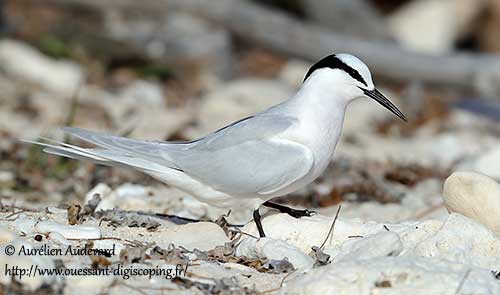
HABITAT:
The Black-naped Tern frequents the coral atolls and usually forages inside lagoons or close to the shoreline. It can be seen on sandy offshore islands, reefs, sand spits and rocky cays. It may occasionally feed at sea.
CALLS AND SONGS: SOUNDS BY XENO-CANTO
The Black-naped Tern utters a high-pitched, repeated “kee-ik”. The alarm call is described as “cheet-cheet-cheeter”.
The calls of the present species are usually harsher than those of other terns.
BEHAVIOUR IN THE WILD:
The Black-naped Tern feeds on small fish (4-8 cm long) of various species.
It usually forages alone, but also sometimes with the Black Noddy - Anous minutus.
It often fish in harbours by snatching prey from the surface rather than diving. However, it also performs plunge-diving while flying, following a short hovering prior to the dive. Surface-dipping is common, including while swimming. It usually forages within two kilometres of the breeding colony.
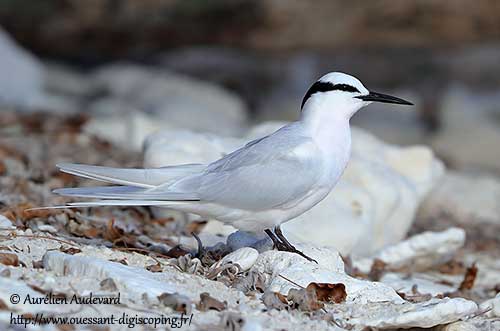
The Black-naped Tern breeds in small colonies, occasionally much larger with up to 200 pairs.
An observation in the Maldives Islands describes the defensive behaviour of a pair during the breeding season.
Two terns were standing together on a sandy beach inside the atoll, less than 15 metres from the waves. The observer walked slowly towards the birds. They did not take off but spread the wings while opening and closing their bills, and sometimes giving series of high-pitched calls. As the observer arrived within 10 metres of the birds, both flew into the air, circling and diving, sometimes hovering just over his head.
This behaviour was performed to protect a nest with an egg, placed among the small stones on the beach. When the observer walked away, the birds returned to the nest. Both adults share the nesting duties.
The Black-naped Tern is resident around some colonies, but it may disperse to the sea from others. The populations from Japan and China winter to the south.
The race S.s. mathewsi is vagrant to coastal E and S Africa.
The flight is direct with graceful wingbeats.
While foraging, small flocks fly buoyantly before diving steeply to pick prey from sea, and sometimes dive into the water.
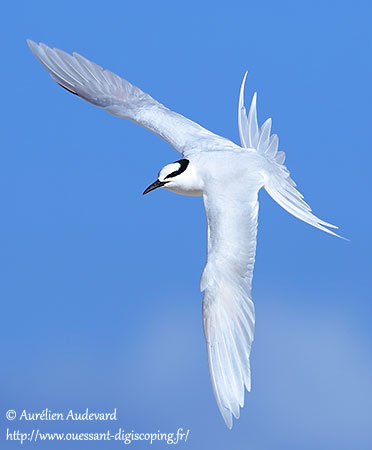
REPRODUCTION OF THIS SPECIES:
The breeding season varies according to the range, and occurs in September/November in Indian Ocean, in September in NE Australia, in July in Philippines, in May in Polynesia, and in November/December in S Great Barrier Reef.
The Black-naped Tern usually breeds in small colonies of 5-20 pairs, sometimes more, up to 200 pairs. It may be associated with other tern species, sometimes with the Silver Gull in New Caledonia.
The nest is an unlined shallow depression in sand, gravel or in coral banks, depending on the range. It is often close to the high-tide line. It is sometimes close to vegetation, and occasionally on artificial structures. No nesting materials are added.
The female lays 2-3, but usually 1-2 greenish-blue eggs with dark speckles. The incubation by both adults lasts 21-23 days. The downy chicks are white to yellow-buff, with blackish marks on body and blackish spots on the head. Bill and legs are reddish-orange. They are brooded for one week.
Both adults defend the nest-site by mobbing predators or performing defensive behaviour (see above “Behaviour in the wild”). Numerous nests are affected or lost by flooding.
PROTECTION / THREATS / STATUS:
The Black-naped Tern is very sensitive to disturbance that may involve nest desertion, but the breeding sites are usually in remote locations. However, they are affected by predation by rats causing losses of both eggs and chicks.
The size of the population is unknown.
The Black-naped Tern is not globally threatened for the moment, and the species is currently evaluated as Least Concern.
